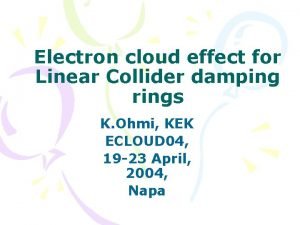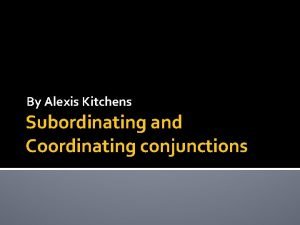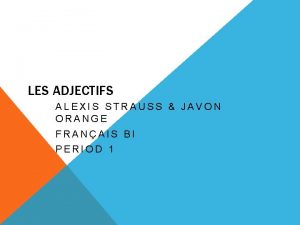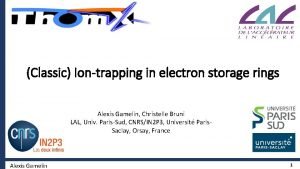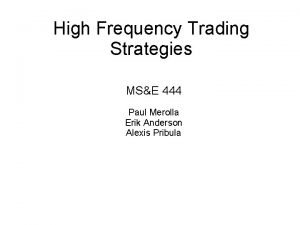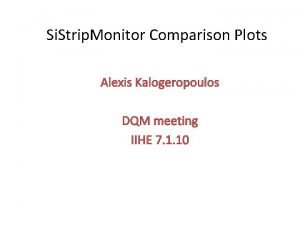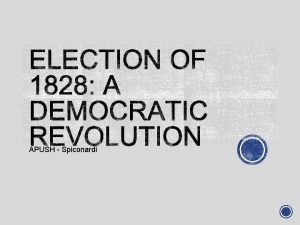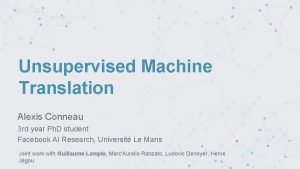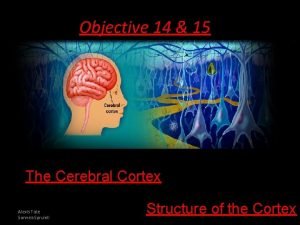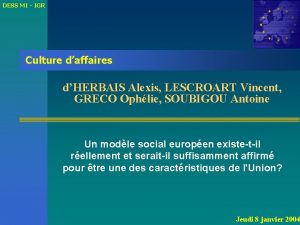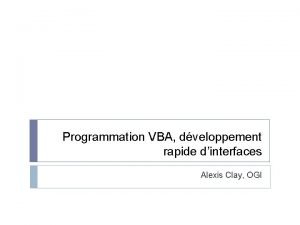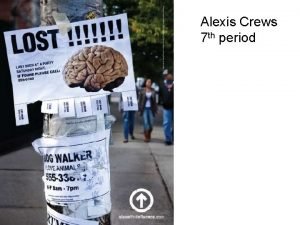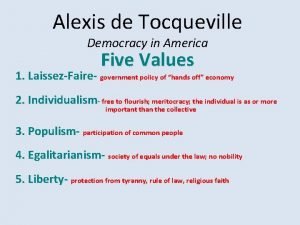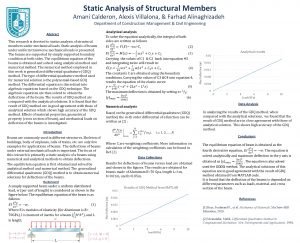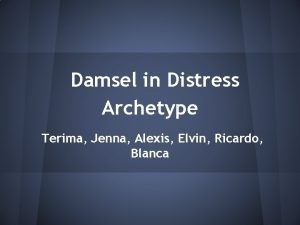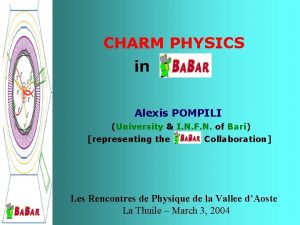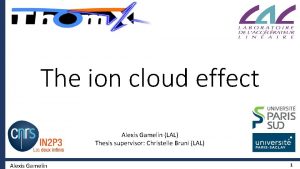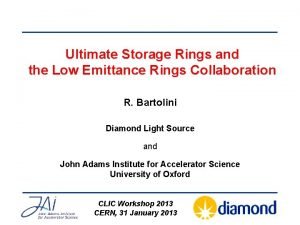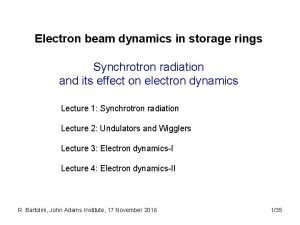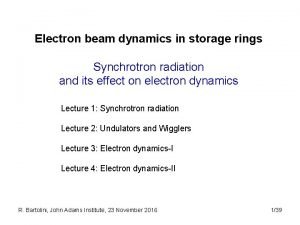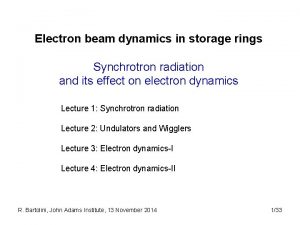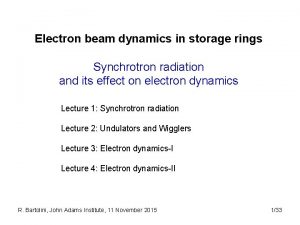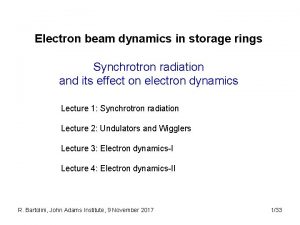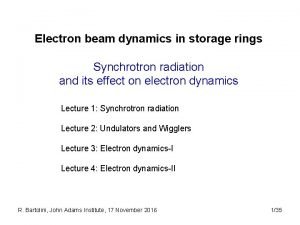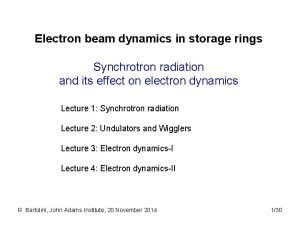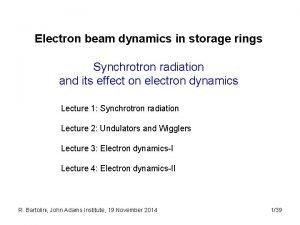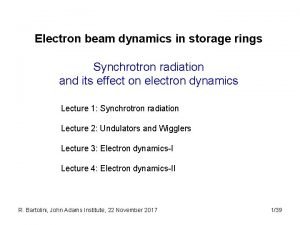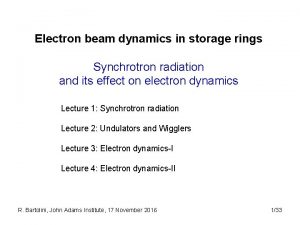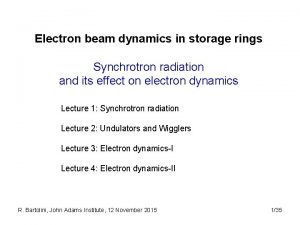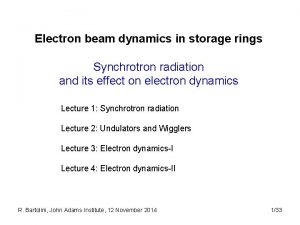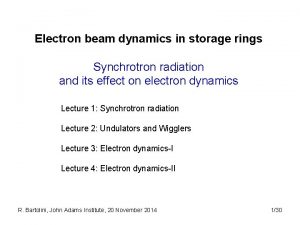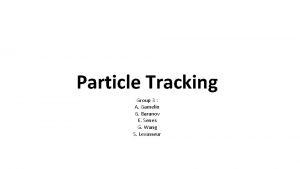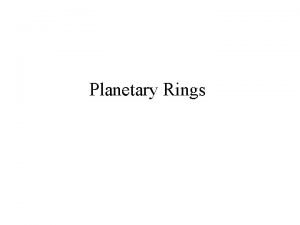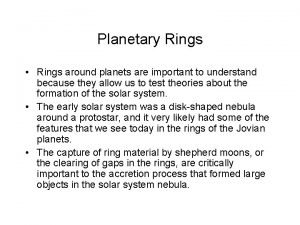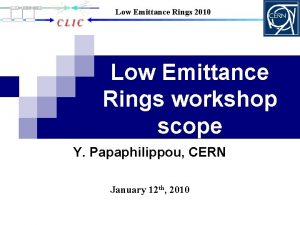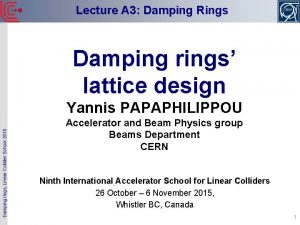Classic Iontrapping in electron storage rings Alexis Gamelin


![I] Some theory Overview Ø Transverse beam-ion interaction Ø Longitudinal beam-ion interaction Ø Effect I] Some theory Overview Ø Transverse beam-ion interaction Ø Longitudinal beam-ion interaction Ø Effect](https://slidetodoc.com/presentation_image_h/006bded4872bdd5580bbb50c5f8f3656/image-3.jpg)



![Effect of dipole magnets Ion M+ y Beam x s Alexis Gamelin [3] Y. Effect of dipole magnets Ion M+ y Beam x s Alexis Gamelin [3] Y.](https://slidetodoc.com/presentation_image_h/006bded4872bdd5580bbb50c5f8f3656/image-7.jpg)




![I] Some theory Overview Ø Transverse beam-ion interaction Ø Longitudinal beam-ion interaction Ø Effect I] Some theory Overview Ø Transverse beam-ion interaction Ø Longitudinal beam-ion interaction Ø Effect](https://slidetodoc.com/presentation_image_h/006bded4872bdd5580bbb50c5f8f3656/image-12.jpg)

















![I] Some theory Overview Ø Transverse beam-ion interaction Ø Longitudinal beam-ion interaction Ø Effect I] Some theory Overview Ø Transverse beam-ion interaction Ø Longitudinal beam-ion interaction Ø Effect](https://slidetodoc.com/presentation_image_h/006bded4872bdd5580bbb50c5f8f3656/image-30.jpg)

















- Slides: 47

(Classic) Ion-trapping in electron storage rings Alexis Gamelin, Christelle Bruni LAL, Univ. Paris-Sud, CNRS/IN 2 P 3, Université Paris. Saclay, Orsay, France Alexis Gamelin 1

Introduction Ø The residual gas in an accelerator can be ionized by several effects like collisions with the beam or synchrotron radiation Ø The resulting ions can be trapped in the negative beam potential of the electron beam Ø The ion cloud effect on the electron beam can be divided in two parts : • The effect of the electric field produced by the ion cloud distribution which leads to tune shift, tune spread, halo increase and emittance blow-up. • The oscillation of the ion cloud within the electron beam potential which can lead to an instability. Ø Possible mitigations to clear the ions are: • Gap in the bunch train • Beam shaking • Clearing electrodes Ø To design effective mitigation strategies it is crucial to understand the ion dynamics and all the elements which can affect the ion behaviour inside the accelerator Alexis Gamelin 2
![I Some theory Overview Ø Transverse beamion interaction Ø Longitudinal beamion interaction Ø Effect I] Some theory Overview Ø Transverse beam-ion interaction Ø Longitudinal beam-ion interaction Ø Effect](https://slidetodoc.com/presentation_image_h/006bded4872bdd5580bbb50c5f8f3656/image-3.jpg)
I] Some theory Overview Ø Transverse beam-ion interaction Ø Longitudinal beam-ion interaction Ø Effect of dipoles and magnetic mirror effect II] Simulations: Ion dynamics Ø A compact storage ring: Thom. X Ø A 3 rd generation light source: Soleil Ø A 4 th generation light source: APS-U III] Simulations: Mitigation strategies Ø Clearing electrodes Ø Clearing gaps Alexis Gamelin 3

A model to describe the beam-ion interaction The model gives the kick that an ion will feel when the electron beam is going through the beam pipe: M+ Electron bunch The model: • Bassetti-Erskine formula 1 for transverse dynamics Number of e- in a bunch Ion position Assumptions: • “Strong-weak” model of the beam-beam interaction • Electron bunch is supposed Gaussian Beam size at the ion position Alexis Gamelin [1] Bassetti and Erskine, Closed expression for the electrical field of a two-dimensional Gaussian charge. Technical report, 1980. 4

A model to describe the beam-ion interaction The longitudinal part of the beam-ion interaction comes from the fact that the beam has a non-uniform transverse beam size: M+ Beam envelope e. The model: • Bassetti-Erskine formula 1 for transverse dynamics • Sagan formula 2 for longitudinal dynamics Dispersion function and derivative Alexis Gamelin Energy spread Assumptions: • “Strong-weak” model of the beam-beam interaction • Electron bunch is supposed Gaussian • The beam trajectory is quasi-parallel to the longitudinal axis The ion dynamics are determined by the optics and the lattice design [2] David Sagan. Some aspects of the longitudinal motion of ions in electron storage rings. Nucl. Instr. Meth. A, 1991. 5

Effect of dipole magnets Ion y x s Alexis Gamelin No global longitudinal displacement Image: Eurofusion 6
![Effect of dipole magnets Ion M y Beam x s Alexis Gamelin 3 Y Effect of dipole magnets Ion M+ y Beam x s Alexis Gamelin [3] Y.](https://slidetodoc.com/presentation_image_h/006bded4872bdd5580bbb50c5f8f3656/image-7.jpg)
Effect of dipole magnets Ion M+ y Beam x s Alexis Gamelin [3] Y. Miyahara, K. Takayama, and G. Horikoshi, Dynamical analysis on the longitudinal motion of trapped ions in an electron storage ring NIM Sec. A (1988). 7

Effect of dipoles magnets With the beam and a dipole field, the resulting motion is a combination of the two motions: M+ Beam y x s Alexis Gamelin [3] Y. Miyahara, K. Takayama, and G. Horikoshi, Dynamical analysis on the longitudinal motion of trapped ions in an electron storage ring NIM Sec. A (1988). 8

Magnetic mirror effect An ion coming from a magnetic field free region which enters the dipole can be reflected by the fringe field: Ø Condition for reflection: Horizontal positon x M+ Longitudinal position s Alexis Gamelin [2] Y. Miyahara, K. Takayama, and G. Horikoshi, Dynamical analysis on the longitudinal motion of trapped ions in an electron storage ring NIM Sec. A (1988). 9

Magnetic mirror effect: Simulation Condition for reflection: Simulation parameters: Alexis Gamelin 10

NUAGE, ion cloud tracking Tracking in magnetic elements (dipoles, quadrupoles) by solving ODE The following effects impact the ion cloud dynamics: • Beam-ion interaction • Ion trapping in magnetic field Included in • Clearing electrodes NUAGE a data parallel Matlab code for ion cloud tracking developed at LAL • Gaps in bunch train • Ion cloud collective effects (self space charge, …) Interpolation of the 3 D field maps of the clearing electrodes Not included in NUAGE In NUAGE, the ion cloud is defined at the start of the simulation (composition, number of ions, …) and tracked during a fixed time length. The simulation does not include the generation of new ions during the tracking. Alexis Gamelin 11
![I Some theory Overview Ø Transverse beamion interaction Ø Longitudinal beamion interaction Ø Effect I] Some theory Overview Ø Transverse beam-ion interaction Ø Longitudinal beam-ion interaction Ø Effect](https://slidetodoc.com/presentation_image_h/006bded4872bdd5580bbb50c5f8f3656/image-12.jpg)
I] Some theory Overview Ø Transverse beam-ion interaction Ø Longitudinal beam-ion interaction Ø Effect of dipoles and magnetic mirror effect II] Simulations: Ion dynamics Ø A compact storage ring: Thom. X Ø A 3 rd generation light source: Soleil Ø A 4 th generation light source: APS-U III] Simulations: Mitigation strategies Ø Clearing electrodes Ø Clearing gaps Alexis Gamelin 12

A compact storage ring: Thom. X Alexis Gamelin 13

Alexis Gamelin 14

Accumulation points Alexis Gamelin 15

Expulsion zones Drift free regions Alexis Gamelin 16

Evolution of the CO+ ions longitudinal distribution during 100 000 turns from uniform distribution Dipole = Alexis Gamelin NUAGE simulation, number of macro ions at start : 100 000 17

Evolution of the CO+ ions longitudinal distribution during 100 000 turns from uniform distribution Dipole = Alexis Gamelin NUAGE simulation, number of macro ions at start : 100 000 18

Evolution of the CO+ ions longitudinal distribution during 100 000 turns from uniform distribution Dipole = Alexis Gamelin NUAGE simulation, number of macro ions at start : 100 000 19

3 rd generation light source: Soleil Alexis Gamelin 20

3 rd generation light source: Soleil Alexis Gamelin 21

3 rd generation light source: Soleil Expulsion zones Accumulation points Drift free regions Alexis Gamelin 22

3 rd generation light source: Soleil Alexis Gamelin 23

3 rd generation light source: Soleil Slow oscillations in drift free regions due to expulsion zones Alexis Gamelin 24

4 th generation light source: APS-U Alexis Gamelin 25

4 th generation light source: APS-U Condition for ion trapping in linear theory 5: APS-U parameters: Gas composition (simulations): H 2: 43% CO: 40 % CO 2: 13% CH 4: 4% Alexis Gamelin [5] G. H. Hoffstaetter, M. Liepe / Nuclear Instruments and Methods in Physics Research A 557 (2006) 205– 212 26

4 th generation light source: APS-U Alexis Gamelin 27

4 th generation light source: APS-U Alexis Gamelin 28

4 th generation light source: APS-U Alexis Gamelin 29
![I Some theory Overview Ø Transverse beamion interaction Ø Longitudinal beamion interaction Ø Effect I] Some theory Overview Ø Transverse beam-ion interaction Ø Longitudinal beam-ion interaction Ø Effect](https://slidetodoc.com/presentation_image_h/006bded4872bdd5580bbb50c5f8f3656/image-30.jpg)
I] Some theory Overview Ø Transverse beam-ion interaction Ø Longitudinal beam-ion interaction Ø Effect of dipoles and magnetic mirror effect II] Simulations: Ion dynamics Ø A compact storage ring: Thom. X Ø A 3 rd generation light source: Soleil Ø A 4 th generation light source: APS-U III] Simulations: Mitigation strategies Ø Clearing electrodes Ø Clearing gaps Alexis Gamelin 30

Clearing electrode with longitudinal field Ø Depending on the electrode geometry it is possible to generate a longitudinal field in addition to the transverse field Simulation results for 500 V (CO+ ions): % of ions remaining Electrode n° 1 Config: -/- Ø The clearing efficiency could be improved further if the electrodes are designed with this idea in mind Ø The electrodes can be button BPMs y Electrode n° 2 Alexis Gamelin s x Config: -/+ Design of the clearing electrodes – Type Soleil BPM 31

Evolution of the CO+ ions longitudinal distribution during 100 000 turns from uniform distribution Dipole = Alexis Gamelin NUAGE simulation, number of macro ions at start : 100 000 32

Evolution of the CO+ ions longitudinal distribution using clearing electrodes (Thom. X) Dipole = Alexis Gamelin Clearing electrode = NUAGE simulation, number of macro ions at start : 100 000 33

Ion-Trapping due to dipoles Two cases: Ø Case a°) low velocity ion stuck in between two dipoles Ø Case b°) accumulation point near dipole location Magnetic mirror effect M+ Dipole magnets Alexis Gamelin Magnetic mirror effect Longitudinal beam-ion force M+ Dipole magnet Accumulation point 34

Evolution of the CO+ ions longitudinal distribution using clearing electrodes (Thom. X) Case a°) Case b°) Dipole = Alexis Gamelin Clearing electrode = NUAGE simulation, number of macro ions at start : 100 000 35

Clearing gap, mixing ion positions Injection Beam in Thom. X ring: 20 ms Gap: 4 μs Beam in Thom. X ring: 20 ms Thom. X Cycle: Dump When there is no beam, ions are freed from beam potential well. The gap cleans a small part of the ions and « mix up » ion positions. Alexis Gamelin NUAGE simulation, number of macro ions at start : 39 000 36

Evolution of the CO+ ions longitudinal distribution after clearing gap Dipole = Alexis Gamelin Clearing electrode = NUAGE simulation, number of macro ions at start : 39 000 37

Clearing efficiencies Ø Good positioning of a few electrodes at the nearest of the accumulation points allows to clear more than 50 % of all the ions generated Alexis Gamelin 38

Neutralisation factor Alexis Gamelin 39

Neutralisation factor Alexis Gamelin 40

General conclusions from this study • The longitudinal displacement of ion clouds is usually neglected but it can have an important impact. Understanding it helps to design effective mitigation strategies. • Possibility to use clearing electrode with longitudinal electric field for more effectiveness, to be demonstrated in Thom. X. • Nearly no ion cloud effects in low emittance rings ? To be verified experimentally • Ion cloud can still be problem for many type of accelerators: injector facilities, ERLs and compact rings. Alexis Gamelin 41

Thank you ! Many thanks to Ryutaro Nagaoka (Soleil) and Joseph Calvey (APS) for providing the inputs needed for the simulations ! Alexis Gamelin 42

Backups Alexis Gamelin 43

Alexis Gamelin 44

Thom. X, a storage ring without damping • Thom. X is a Compton Backscattering Source (CBS) of X rays under construction at LAL. • The e- bunch is stored for 20 ms then it is dumped while a new one is injected. e- Ph ot on • Because of the short storage time and the low electron energy there is no synchrotron radiation damping. X-ra y ph oto n IP Alexis Gamelin 45

Local neutralisation factor It is possible to define a local neutralisation factor 3 which take into account the fact that the neutralisation is not homogeneous along the ring longitudinal position: The mean value of the local neutralisation factor gives back the usual neutralisation factor: Alexis Gamelin [3] A, Poncet, Ion trapping, clearing, beam-ion interactions, 1999. 46

Induced tune shift Usually no information about the local neutralization factor is known so mean values are used: No clearing 9, 94 E-4 1, 52 E-4 6, 5 1, 14 E-3 5, 84 E-4 2, 0 Clearing 2, 24 E-4 3, 23 E-5 6, 9 2, 78 E-4 1, 24 E-4 2, 2 Configuration Ratio The same type of approach is possible for other effects induced by ions like emittance growth, tune spread, pressure increase, … Alexis Gamelin [4] L. Wang et al, Suppression of beam-ion instability in electron rings with multibunch train beam flings, PRST-AB, 2011. 47
 Electron cloud rings
Electron cloud rings Primary storage and secondary storage
Primary storage and secondary storage Secondary storage provides temporary or volatile storage
Secondary storage provides temporary or volatile storage Unified storage vs traditional storage
Unified storage vs traditional storage Primary storage vs secondary storage
Primary storage vs secondary storage Subordinating conjuctions
Subordinating conjuctions Rainforest biome project
Rainforest biome project Alexis strauss
Alexis strauss Alexis deane
Alexis deane English
English Alexis
Alexis Alexis barrientos
Alexis barrientos Alexis mayers
Alexis mayers Alexis sherman
Alexis sherman Pastor alexis romero
Pastor alexis romero Alexis duffaure
Alexis duffaure Automatiss
Automatiss Xxnx ica
Xxnx ica Alexis brown
Alexis brown Alexis kalogeropoulos
Alexis kalogeropoulos Alexis de tocqueville apush
Alexis de tocqueville apush Alexis de tocqueville’s five values
Alexis de tocqueville’s five values Alexis doussot
Alexis doussot Alexis conneau
Alexis conneau Jonbenét ramsey john andrew ramsey
Jonbenét ramsey john andrew ramsey Alexis tate
Alexis tate Alexis terrazas xxx
Alexis terrazas xxx Alexis schauss nc dpi
Alexis schauss nc dpi Alexis rostand
Alexis rostand Alexis d'herbais
Alexis d'herbais Excel userform multipage
Excel userform multipage Crews7
Crews7 Alexis carrel
Alexis carrel Dorothea puente 2011
Dorothea puente 2011 Gort-5
Gort-5 Alexis telecom pvt ltd
Alexis telecom pvt ltd Alexis de tocqueville 5 values
Alexis de tocqueville 5 values Alexis quintana
Alexis quintana Alexis farah
Alexis farah Alexis villalona
Alexis villalona Alexis johnston
Alexis johnston Alexis eller
Alexis eller Damsel archetype
Damsel archetype Alexis pompili
Alexis pompili Alexis joy d'achille obituary
Alexis joy d'achille obituary Emily critchfield
Emily critchfield Alexis carr
Alexis carr Alexis noel
Alexis noel
